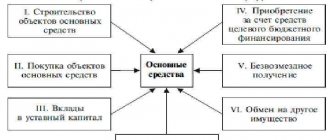What expenses are considered other in accounting?
All expenses of any organization can be simplified into those related to its core activities and other expenses. It is necessary to generate the necessary data on other expenses in accounting on the basis of Chapter. 3 PBU 10/99.
According to clause 11 of this regulatory act, other expenses include expenses arising:
- when leasing the organization's assets for temporary use;
- when transferring rights to use intellectual property;
- from participation in the authorized capital of other organizations;
- upon disposal of fixed assets and other assets, with the exception of cash (except foreign currency), goods, services;
- for the use of credits and loans;
- when using the services of credit institutions;
- in connection with the creation of reserve funds;
- in the form of fines for non-compliance with the terms of the contract;
- as losses of previous years recognized in a given year;
- due to the impossibility of collecting accounts receivable for many years;
- in the form of exchange rate differences;
- as a result of asset depreciation;
- when paying for various charitable and cultural and entertainment events;
- other expenses.
For other expenses in accounting, this list is open.
For a commercial company, other expenses, as well as costs associated with its main activity, are an important part of the accounting system, since this information influences the adoption of correct management decisions.
The following requirements apply to expenses in accounting:
- they must be carried out on the basis of any agreement or in accordance with the law;
- expenses are accurately defined in monetary terms;
- there is no doubt that the expenditure transaction will lead to a decrease in economic benefits.
To learn more about reflecting results not related to core activities, read the article “Accounting for other income and expenses (nuances).”
Other income in the income statement
Others include income receipts (if they are not the main ones depending on the type of activity) received from (clause 7 of PBU 9/99):
- OS sales;
- leasing property or granting the right to use intellectual products;
- payment of penalties for violation of obligations under concluded agreements;
- the value of assets accepted free of charge;
- revealed profits of previous years;
- compensation for damage;
- posting overdue debts to creditors;
- positive exchange rate differences, additional valuations of previously discounted financial investments, fixed assets and intangible assets, etc.
It is impossible to see other income in the balance sheet, but a separate line is provided for them in the financial financial statements. The totality of similar income available in the reporting period is reflected in line 2340 of the financial structure. This value is determined as the amount of the account’s credit turnover. 91/1, excluding data on accounting for interest received and participation in the management capital of other companies (there are separate lines for them in the OFR), reduced by the debit turnover for the payment of VAT and excise taxes.
Postings for accounting for other expenses
Transactions on other expenses are reflected in account 91 “Other income and expenses”, the debit of which records expenses, and the credit records income. For ease of accounting, it is recommended to use subaccounts:
91-1 “Other income”;
91-2 “Other expenses”;
91-9 “Balance of other income and expenses.”
Account 91 at the end of each month does not have a balance - debit and credit turnovers are calculated, their total balance is displayed and recorded on subaccount 91-9 in correspondence with account 99 “Profits and losses”.
The wiring will look like this:
Dt 91-9 Kt 99 - profit made;
Dt 99 Kt 91-9 - losses received.
It is recommended to keep analytical accounting of other expenses in account 91 separately for each of the operations in order to have before your eyes a complete picture of their impact on the results of the company’s work.
The total balance on account 91 on the last day of the month is zero, but debit and credit amounts have been accumulated on its subaccounts since the beginning of the year. At the end of December, amounts from subaccounts 91-1 and 91-2, collected for the year by internal postings, are transferred to subaccount 91-9:
Dt 91-1 Kt 91-9 - transfer of the balance of other income.
Dt 91-9 Kt 91-2 - transfer of the balance of other expenses.
In the financial statements, other expenses are indicated in the income statement on line 2350.
General provisions about the Report
The financial results statement is one of the fundamental final accounting documents. Until 2013, it bore a name that reflected only the final indicator of business activity: profit or loss. Now it is clear from it that the content of the reporting document includes, in addition to the level of profit achieved or loss incurred, other indicators.
Financial statements
Based on the information presented in the final financial statements, an assessment is made of the financial and economic position of the company, the level of its profitability and liquidity, and operational stability. It is necessary to predict the future performance of a business, therefore it is used by almost all counterparties: government agencies, banking institutions, partners, investors.
The form for drawing up a financial report was approved by the Ministry of Finance by order No. 66 n of 2010 and is presented in the first appendix to it under the previously existing name “Profit and Loss Statement”. Information from this document supplements the information included in the main body of the company - the balance sheet.
If the balance sheet shows that a business entity has active funds and liabilities at the end of the reporting year, then from the report you can find out about the amount of income it has achieved over the past period of time and the expenses it has incurred in the course of business, the receipt of net profit or loss, i.e. about business performance over the past year.
Conventionally, the structure of the report under consideration is represented by four large sections:
- Company income and costs by main types of business activity.
- Amounts of income and expenses that differ from the main expenses and benefits - other.
- The financial result of doing business for the past annual period.
- Reference information.
The report is compiled for the entire enterprise, regardless of the tax regime used, under which it operates and whether it has independent structural divisions.
Annual data
In addition to the indicators of the reporting year, for example, for 2020, the document provides information for the same previous period, i.e. for 2020. As follows from the rule established by clause 10 of PBU 4/99, if the information for two adjacent years turns out to be incomparable, it must be brought to a comparable form by adjusting it.
PBU 9/99, dedicated to the profitability of companies, PBU 10/99, regulating expenses, classify all income and expenses of business entities into two groups:
- from normal (main) activities
- other
Each organization itself decides the issue of assigning certain costs to the first or second group, reflecting the accepted principles of separation in its internal accounting policy. This right is clarified by the Ministry of Finance in letter No. 07-02-06/203.
Other expenses in tax accounting are...
In the practice of every accountant, there are cases when expenses are incurred that are not related to the main commercial activity. Then the question arises: is it possible to reflect these expenses when maintaining tax records? To answer this, you need to refer to Art. 265 “Non-operating expenses” of the Tax Code of the Russian Federation, which contains a list of expenses not related to the main activity justified for reducing the taxable base.
In reality, there are often expenses of an organization that are accepted in accounting, but cannot be taken into account in tax accounting. The accountant must know them well.
These include, in particular:
- fines and penalties for taxes and payments to the state budget;
- expenses for charitable and cultural and entertainment events, etc.
Not all expenses of an organization reflected in accounting can be taken into account when maintaining tax records. This creates temporary differences that must be taken into account in accordance with PBU 18/02.
Advertising expenses
The list of advertising expenses contains paragraph 4 of Article 264 of the Tax Code.
In accounting, advertising costs are reflected in full as part of expenses for ordinary activities. In tax accounting, such costs are taken into account as other expenses.
note
Some types of advertising costs are included in other expenses only within the norms. Advertising costs that exceed the norm do not reduce the company's taxable profit.
The standards within which such costs are taken into account when taxing profits are given in the table:
| Types of advertising expenses | Expense rate |
| Expenses on advertising through the media (including advertisements in print, broadcast on radio and television) and information and telecommunication networks (for example, the Internet). From January 1, 2014, this type of advertising expenses should also include the costs of advertising events for film and video services. | Not standardized |
| Expenses for illuminated and other outdoor advertising, including the production of advertising stands and billboards | Not standardized |
| Costs of participation in exhibitions, fairs and expositions | Not standardized |
| Costs for decorating shop windows, sales exhibitions, sample rooms and showrooms | Not standardized |
| Costs for the production of advertising brochures and catalogs containing information about goods sold, work performed, services provided, trademarks and service marks and (or) about the organization itself | Not standardized |
| Costs of discounting goods that have completely or partially lost their original qualities during exhibition | Not standardized |
| Costs of purchasing (manufacturing) prizes awarded to the winners of drawings of such prizes during mass advertising campaigns | No more than 1% of sales revenue (excluding VAT) |
| Expenses for other types of advertising (for example, costs for the development and distribution of advertising letters, postcards, labels, branded packages, etc.) | No more than 1% of sales revenue (excluding VAT) |
EXAMPLE For the first half of the reporting year, the expenses of Aktiv JSC on television advertising amounted to 195,000 rubles.
(including VAT - 29,746 rubles). In addition, the company bought prizes for the winners of the advertising campaign, worth more than 100 rubles. for a unit. They spent 330,000 rubles on this. (including VAT – 50,339 rubles). Aktiva's revenue from product sales for the first half of the year amounted to RUB 3,600,000. (including VAT – RUB 549,153). In accounting, advertising costs amount to RUB 444,915. (195,000 – 29,746 + 330,000 – 50,339) are reflected as expenses for ordinary activities. In tax accounting, TV advertising costs are included in other expenses in full. The costs of purchasing prizes are included in other expenses within 1% of revenue. This amount will be: (3,600,000 rubles – 549,153 rubles) × 1% = 30,508 rubles. The remaining amount of costs for the purchase of prizes is not taken into account as part of other expenses and does not reduce the taxable profit of the company. This amount will be: 330,000 rubles. – 50,339 rub. – 30,508 rub. = 249,153 rubles. Based on the results of the first half of the year, “Active” can take into account advertising costs in the amount of 195,000 rubles when taxing profits. – 29,746 rub. + 30,508 rub. = 195,762 rub. note
You can deduct the amount of VAT on excess advertising expenses in full (Resolution of the Presidium of the Supreme Arbitration Court of Russia dated July 6, 2010 No. 2604/10).
Priority display of goods
The Ministry of Finance includes among standard advertising expenses the supplier's costs for the priority display of goods by the buyer - a retail trade organization (see, for example, Letter dated March 18, 2014 No. 03-03-06/1/11641). Financiers justify their point of view by the fact that priority display services are aimed at promoting goods and are advertising services. However, this position is not always supported by arbitration courts, which allow merchandising costs to be taken into account in full on the basis of paragraphs. 49 clause 1 art. 264 of the Tax Code of the Russian Federation (see, for example, Resolution of the Federal Antimonopoly Service of the Moscow District dated February 18, 2013 in case No. A40-83540/12-116-180).
Ads
Expenses on advertising of produced (purchased) and (or) sold goods (work, services) and activities of the taxpayer are considered other expenses and are not standardized (subclause 28, clause 1, article 264 of the Tax Code of the Russian Federation). This also applies to this type of advertising, such as promotional videos. For income tax purposes, you can take into account the actual costs of their creation. However, if the costs included in the initial cost of the roller exceed 40,000 rubles, and its useful life is more than 12 months, then you will have to deal with depreciable property (clause 1 of Article 256 of the Tax Code of the Russian Federation). That is, the costs of creating such a video cannot be written off at a time, but only gradually - through depreciation. An advertising video created by the organization is an object of intellectual property and is accounted for as an intangible asset. For audiovisual works, the taxpayer has the right to independently determine the useful life, but it cannot be less than two years. Thus, if an advertising video relates to depreciable property, the costs of its creation can be attributed to advertising expenses, but they will have to be written off in tax accounting gradually - through depreciation charges (letter of the Ministry of Finance of Russia dated March 23, 2020 No. 03-03-06 /1/15750).
Logo making
The logo of an organization is the result of intellectual activity and an equivalent means of individualizing the organization. The costs of its creation and production should be included in advertising expenses as part of other expenses. The Russian Ministry of Finance substantiated this position in a letter dated September 12, 2014 No. 03-03-R3/45762.
Logo is an original design, an image of the full or abbreviated name of a company or a company’s products. It is specially developed by the company in order to attract attention to it and its products. Inventions, trade names, trademarks and service marks are the results of intellectual activity and equivalent means of individualization of legal entities, goods, works, services and enterprises that are provided with legal protection (intellectual property) (Clause 1 of Article 1225 of the Civil Code of the Russian Federation). This means that the organization’s logo is recognized as an object of advertising.
Advertising is information disseminated in any way, in any form and using any means, addressed to an indefinite number of people and aimed at attracting attention to the object of advertising, creating or maintaining interest in it and promoting it on the market (Clause 1, Article 3 of the Law dated March 13, 2006 No. 38-FZ “On Advertising”).
Advertising costs for profit taxation are taken into account as part of other expenses associated with production and sales (subclause 28, clause 1, article 264 of the Tax Code of the Russian Federation). Advertising expenses can be standardized or non-standardized.
Non-standardized advertising expenses include, among other things, expenses for participation in exhibitions, fairs, expositions, for the design of shop windows, sales exhibitions, sample rooms and showrooms, production of advertising brochures and catalogs containing information about goods sold, work performed, services provided, trademarks and service marks, and (or) about the organization itself, for the discounting of goods that have completely or partially lost their original qualities during exposure. Since the logo is an advertisement, the organization has the right to take into account the costs of its production (design) as part of income tax expenses, provided that these expenses are justified and documented.
Tax Code: other expenses for taxation
In order to correctly form the profit received for calculating tax, you must be guided by a special list of non-operating expenses, which contains Art. 265 Tax Code of the Russian Federation. This list includes:
- costs of maintaining the leased property;
- interest paid on loans taken;
- negative exchange rate differences;
- expenses for disposal of fixed assets;
- court fees and charges;
- maintenance of unused property;
- fines for violation of contractual terms.
Non-operating expenses also include losses from natural disasters, bad debts, damage to material assets in the absence of the culprit, etc.
The list of such expenses is open. It may include other expenses of the enterprise that are not related to production and sales. The main thing is that it is necessary to comply with the condition specified in paragraph 1 of Art. 252 of the Tax Code, - expenses are necessary for the full-fledged activities of the organization and must be documented properly and with all the necessary details.
The moment of recognizing an expense for calculating taxes is also stipulated in the Tax Code of the Russian Federation. If, according to the accounting policy of the organization, the accrual method is used, then you need to use the instructions of clause 7 of Art. 272 of the Tax Code of the Russian Federation. When using the cash method, to write off non-operating expenses, you must be guided by clause 3 of Art. 273 Tax Code of the Russian Federation.
You will learn what the Tax Code says about non-operating expenses from the article “Art. 265 of the Tax Code of the Russian Federation: questions and answers.”
Reflection of other income and other expenses in accounting
Accounting for other income and expenses is kept on account 91 of the Chart of Accounts. In this case, other income is recorded as a credit to subaccount 91.01 in correspondence with various accounts, and postings for other expenses are recorded as a debit to subaccount 91.02.
Example
During the 4th quarter of 2020, Alpha LLC, operating within the framework of the general taxation system, carried out the following types of transactions, which are accounted for as other income and expenses:
- Leasing a warehouse space (this type of activity is not the main activity of the company, so this is other income), with a monthly rental amount of 20,000.00 rubles, including VAT of 3,050.85 rubles. The amount of monthly depreciation for this property is 4,500.00 rubles. Utility costs are 2,150.00 rubles.
- The amount of monthly banking services for the company's current account is 3,500.00 rubles.
- On November 5, an inventory of the remaining materials in the warehouse was carried out, as a result of which a surplus was identified for a total amount of 12,350.00 rubles.
- On November 16, a trial took place, as a result of which the arbitration court issued a ruling awarding Alfa LLC compensation for violation of contractual obligations by the contractor in the amount of 30,000.00 rubles.
- On December 6, the founder of Alpha LLC provided the organization with an interest-bearing loan at 6% per annum. The amount of interest on the loan for December amounted to 1,010.00 rubles.
- On December 9, the statute of limitations expired (3 years) for debt in favor of Alpha LLC for goods shipped but not paid for. The cost of the sold batch was 25,000.00 rubles. The company did not create a reserve for doubtful debts.
- On December 22, the company transferred 100,000.00 rubles in favor of a charitable foundation, which is confirmed by the corresponding letter and agreement of intent to transfer the specified amount, signed on the same date.
During the quarter, the accountant of Alpha LLC will record other income and expenses with the following entries:
date Debit Credit Sum Content October 31 62 91.01 20 000,00 Calculation of rent for October October 31 91.02 68.VAT 3 050,85 VAT is charged on the rental of property October 31 91.02 02 4 500,00 Depreciation has been calculated on the property October 31 91.02 60 2 150,00 The amount of utility payments has been accrued under the agreement with the service operating company October 31 91.02 76 3 500,00 Expenses for monthly banking services for a current account November 5 10 91.01 12 350,00 Materials identified during the inventory that were not previously reflected were taken into account November 16 76 91.01 30 000,00 The amount of compensation for violation of contractual obligations receivable is reflected November 30th 62 91.01 20 000,00 Calculation of rent for November November 30th 91.02 68.VAT 3 050,85 VAT is charged on the rental of property November 30th 91.02 02 4 500,00 Depreciation has been calculated on the property November 30th 91.02 60 2 150,00 The amount of utility payments has been accrued under the agreement with the service operating company November 30th 91.02 76 3 500,00 Expenses for monthly banking services for a current account 9th December 91.02 62 25 000,00 The amount of receivables that have expired has been written off December 22 76 91.02 100 000,00 The amount of charitable assistance in favor of the charitable foundation has been determined 31th of December 62 91.01 20 000,00 Calculation of rent for December 31th of December 91.02 68.VAT 3 050,85 VAT is charged on the rental of property 31th of December 91.02 02 4 500,00 Depreciation has been calculated on the property 31th of December 91.02 60 2 150,00 The amount of utility payments has been accrued under the agreement with the service operating company 31th of December 91.02 76 3 500,00 Expenses for monthly banking services for a current account 31th of December 91.02 66 1 010,00 The amount of interest on the loan from the founder is reflected
Results
Reliable reflection of other expenses in accounting and tax accounting helps not only to rid the company of claims from controllers, but also to obtain information for making strategic decisions. Therefore, it is important for an accountant to correctly identify an expense business transaction, using the norms of accounting and tax legislation.
Sources:
- Tax Code of the Russian Federation
- Order of the Ministry of Finance of Russia dated May 6, 1999 No. 33n
You can find more complete information on the topic in ConsultantPlus. Full and free access to the system for 2 days.
Types and classification
It would seem that everything is simple: there is an established list, and we focus on it. But in practice, there is also a division of MH into:
This gradation is also provided for in tax accounting. In particular, Article 318 of the Tax Code of the Russian Federation. True, taxpayers are given the right to independently establish a list of direct MH, but in compliance with the established requirements for them. According to the norms of the Tax Code of the Russian Federation, direct material costs are:
- expenses of the organization for the purchase of raw materials and materials directly used in the production of goods (performance of work, provision of services), which are a necessary component or generally form the basis of the product;
- company expenses for the purchase of components undergoing installation or semi-finished products undergoing additional processing.








